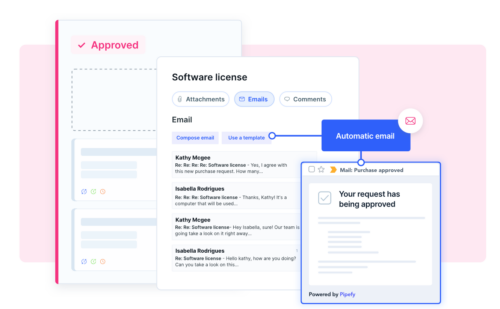
Business process management (BPM) has been around for decades, but technological advancements in BPM have been relatively few and far between. While the framework of BPM remained intact, the most significant improvement in BPM came about with the arrival of process management and automation software.
These platforms offer businesses new tools for modeling, assessing, and optimizing their processes, and they uncover new efficiency gains through their abilities to automate processes and integrate with existing tech stacks. Now, the fusion of business process management with AI technologies like OpenAI and GPT-4 is rapidly transforming the way companies build and manage their processes.
The IT Guide to Workflow Management
Build the best version of any workflow for any team.

What is AI?
Artificial intelligence is a discipline that combines computer science with data, in order to solve complex problems. AI also refers to the use of machine learning, natural language processing, deep learning, and algorithms to analyze data and make predictions. Generative AI can also learn and replicate coding languages.
The use of artificial intelligence has exploded over the past couple of years, but it has received a lot of attention since the beginning of 2023. In March, OpenAI launched GPT-4, a multimodal large language model that replaced the previous version, GPT-3.
Like its predecessor, GPT-4 “learns” by processing and analyzing vast amounts of data. GPT-4 is capable of generating text, producing data analytics, predicting outcomes, and completing an array of complex operations. Users interact with the model by giving it commands in natural language.
Applications for GPT-4 are essentially limitless. The technology is already being widely used in chatbots, where it responds to queries and delivers relevant information to users. More advanced use cases include creating original content, deep data analysis, predictive analytics, classification of medical records, and even the successful (if not quite practical) completion of various aptitude tests.
What is AI in business process management?
AI in business process management refers to the use of AI capabilities to build, analyze, automate, and optimize processes and workflows. AI helps businesses improve operational efficiency and create streamlined processes.
For example, before the introduction of AI in BPM, most teams would build their processes by manually creating process maps that required a lot of time and effort. Now, AI can do the heavy lifting of building a process. All users have to do is tell the AI what process they need, which data they want to track, and any other specifications. AI does the rest.
Another way AI is impacting business process management is through its ability to speed up data analysis. AI can organize and analyze troves of data very quickly, which saves teams hours of time. In turn, this faster data analysis helps businesses make better tactical and strategic decisions. AI supports better decision making by:
- Revealing trends
- Predicting outcomes
- Identifying root causes
- Automating manual tasks
- Assessing process and team performance
What is the role of AI in business process management?
The role of AI in process management is composed of three primary components: data analysis, process building, and automation. AI holds tremendous potential for business process management. All users — including business leaders, process managers, and practitioners — benefit from the use of AI.
For example, AI can help users build the most efficient version of a process or workflow based on previous data and parameters set by the user. AI can also quickly crunch numbers to generate answers to questions about efficiency or performance, so that decisions can be made more quickly and with more confidence.
| Data analysis | AI sifts through data to help leaders and their teams make better tactical and strategic decisions. |
| Process building | AI creates new processes and workflows based on parameters and requirements set by the user. |
| Automation | AI automates previously manual tasks to save time and effort. |
Examples of AI in BPM
Businesses use AI in a number of ways. The goal of AI in business process management is usually to increase efficiency and better understand data, and these goals are priorities for almost every team in every department.
Below are examples of how AI can be applied in process management for finance, HR, and sales.
Finance
Examples of the use of AI for finance-related processes include procurement, purchasing, accounts payable, accounts receivable, and reimbursement. AI can help these teams avoid late payments and penalties by staying ahead of deadlines, and it can provide in-depth analysis of financial information such as identifying accounts that are at risk of becoming delinquent.
AI helps these teams by providing deeper visibility into large volumes of data, creating charts, automating or structuring approval flows, and providing predictive analytics. AI also makes it easier for finance teams to zero in on particular data points and modify their workflows and processes as needed, without having to send every request to the IT team.
Common use cases for AI in finance processes include:
- Fraud detection
- Service chatbots
- Risk management
- Credit scoring
- Document analysis
- Supplier selection and evaluation
- Demand forecasting
- Spend analysis
- Automating manual tasks such as invoice processing, reconciliation, and approval
HR
Artificial intelligence helps HR teams by increasing objectivity, improving employee experiences, and helping answer complex questions, such as when (and how much) an employee’s salary should be increased.
Consider one example: salary negotiations. Typically, compensation teams rely on a vast array of spreadsheet data and subjective judgment to determine how much to offer a new hire. AI can consolidate many data points such as performance, seniority, budget, and market trends to help a manager understand how to prepare a fair but competitive offer.
Other use cases for AI in process management include:
- Recruiting
- Candidate selection
- Employee onboarding
- Personalizing career paths
- Organizing unstructured data
- Automating manual administrative tasks
- Identifying and anticipating attrition trends
- Providing responses to common employee questions
- Giving HR teams more face time with employees and candidates
Sales
Another example of AI in business process management is its use in sales. Sales processes are notoriously complex and fragmented, and this is due to variables related to each prospect and sales team member. AI helps sales teams improve the consistency and effectiveness of their processes by automating aspects of the sales process and therefore giving sales teams more time for selling.
AI also helps sales teams by recommending the most effective sales channel to reach a prospect, suggesting likely upsell opportunities, and prioritizing leads. Other uses for AI in the sales process include:
- Lead scoring
- Drafting content for emails
- Automating administrative tasks
- Assisting prospects by providing information through chatbots
- Personalizing sales journeys
Other processes that benefit from AI
AI can be applied to any type of business process. That includes both core and support (back office) processes, as well as the longtail or ad hoc processes that inevitably arise as business needs and tech stack change. Here are some examples of the types of business processes that can be improved with AI:
| Core processes | Production Marketing Fulfillment Customer Support Product Development |
| Support processes | Request management IT service desk Procure-to-pay Recruiting Facilities management |
| Longtail processes | Contract review Document management Contractor management Vendor approval New-hire requests Fleet management Budget requests for special projects |
How to use AI to manage business processes
Teams that are ready to apply AI to their processes will need to add an AI tool to their tech stack. The right tool will depend on a number of factors, including its ability to integrate with existing apps and systems, and the degree of no-code functionality required.
No-code tools such as Pipefy AI help teams build, automate, and optimize their operations, processes, and workflows quickly with zero prior experience in either coding or AI. Users simply tell the AI what they need, and it takes care of the rest.
The IT team will play a key role in the selection and implementation of any AI tool, and their evaluation will include things like security, cost, integrations, effort to implement, and ROI. For most teams, the best way to get started is to understand the value that AI can bring to their current processes, secure alignment with managers and leaders, and then collaborate with IT to find the right solution for their needs.






